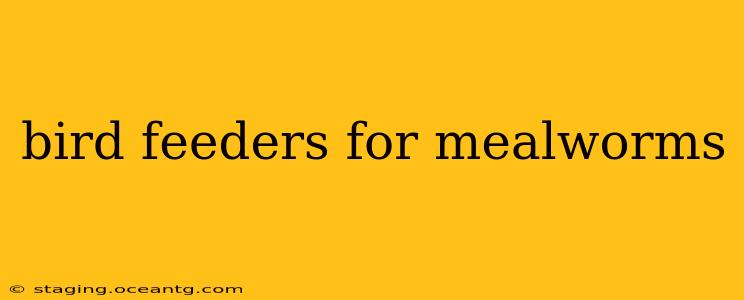Mealworms are a fantastic source of protein for many bird species, offering a nutritious and irresistible treat. While many birds will readily consume mealworms scattered on the ground, using a dedicated bird feeder designed for mealworms can significantly improve your success in attracting and feeding these feathered friends. This guide explores the best types of feeders for mealworms, offering insights into their design, benefits, and how to choose the right one for your needs.
What are the best types of bird feeders for mealworms?
Several feeder types excel at dispensing mealworms effectively. The key features to look for are ease of cleaning, prevention of spillage and spoilage, and a design that keeps the mealworms accessible to birds while deterring larger animals, like squirrels, from raiding your supply.
1. Tray Feeders: Simple tray feeders are excellent for mealworms. The open design allows easy access for birds, and you can simply spread the mealworms across the tray. However, be aware that these are more susceptible to rain and spillage, and the mealworms can dry out quickly. Consider covering the tray to mitigate some of these drawbacks.
2. Suet Feeders with Mealworm Compartments: Many suet feeders offer compartments or cages specifically designed for mealworms. This keeps the mealworms separate from the suet and helps to prevent them from getting mixed with other birdseed, reducing waste and spoilage. These are a good option for combining multiple food types.
3. Tube Feeders with Mealworm Ports: Some tube feeders have small openings or ports specifically designed to dispense mealworms. These can be effective at preventing larger birds from monopolizing the feed and allow smaller birds better access. These designs may require a little more effort to fill.
4. Platform Feeders with Sides: A platform feeder with raised sides is a great option as it provides protection from the elements and reduces spillage. The elevated platform offers convenient access for many bird species.
What kind of bird feeder should I avoid for mealworms?
Avoid feeders that are difficult to clean thoroughly, as mealworms can spoil quickly. This can attract unwanted insects and potentially harm the birds. Feeders with narrow openings that are difficult for birds to access also aren't ideal for mealworms.
How often should I refill a mealworm feeder?
This depends on the number of birds visiting your feeder and the quantity of mealworms you provide. It is advisable to check your feeder at least daily and refill it whenever necessary. Remember to remove any spoiled or uneaten mealworms to prevent the spread of disease and bacteria.
Can I use live or dried mealworms in a bird feeder?
Both live and dried mealworms are suitable for bird feeders. Live mealworms provide a more stimulating foraging experience for birds, but they need to be replenished more frequently as they can crawl away or die. Dried mealworms are more convenient but may not be as appealing to some birds.
What are the benefits of using a mealworm feeder?
- Attracts a wider variety of birds: Mealworms are a high-protein food source that attracts many bird species, including those that are less attracted to other seed types.
- Supplements a balanced diet: Mealworms provide essential nutrients, complementing the benefits of other birdseed mixes.
- Easier feeding: Feeders designed specifically for mealworms simplify the feeding process and reduce spillage.
- Reduces waste: Dedicated compartments help reduce the mealworm wastage often associated with scattering them on the ground.
How do I keep mealworms fresh in my bird feeder?
Keeping mealworms fresh in your bird feeder is key to maintaining its appeal to birds and preventing spoilage. The best solution depends on the type of feeder and weather conditions. For open trays, try covering them to prevent rain and excessive sun exposure. For enclosed feeders, ensure adequate ventilation to prevent moisture buildup which can lead to mold and spoilage.
By selecting the appropriate mealworm feeder and following these simple tips, you can greatly increase your success in attracting a diverse array of birds to your backyard while providing them with a nutritious and enjoyable food source. Remember to observe the birds that visit your feeder and adjust your strategy as needed to provide the best possible experience.
